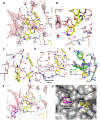2,4,5-Trisubstituted Pyrimidines as Potent HIV-1 NNRTIs: Rational Design, Synthesis, Activity Evaluation, and Crystallographic Studies
- PMID: 33734714
- PMCID: PMC8594587
- DOI: 10.1021/acs.jmedchem.1c00268
2,4,5-Trisubstituted Pyrimidines as Potent HIV-1 NNRTIs: Rational Design, Synthesis, Activity Evaluation, and Crystallographic Studies
Abstract
There is an urgent unmet medical need for novel human immunodeficiency virus type 1 (HIV-1) inhibitors that are effective against a variety of NNRTI-resistance mutations. We report our research efforts aimed at discovering a novel chemotype of anti-HIV-1 agents with improved potency against a variety of NNRTI-resistance mutations in this paper. Structural modifications of the lead K-5a2 led to the identification of a potent inhibitor 16c. 16c yielded highly potent anti-HIV-1 activities and improved resistance profiles compared with the approved drug etravirine. The co-crystal structure revealed the key role of the water networks surrounding the NNIBP for binding and for resilience against resistance mutations, while suggesting further extension of 16c toward the NNRTI-adjacent site as a lead development strategy. Furthermore, 16c demonstrated favorable pharmacokinetic and safety properties, suggesting the potential of 16c as a promising anti-HIV-1 drug candidate.
Figures







Similar articles
-
Development of Novel Dihydrofuro[3,4-d]pyrimidine Derivatives as HIV-1 NNRTIs to Overcome the Highly Resistant Mutant Strains F227L/V106A and K103N/Y181C.J Med Chem. 2022 Feb 10;65(3):2458-2470. doi: 10.1021/acs.jmedchem.1c01885. Epub 2022 Jan 21. J Med Chem. 2022. PMID: 35061384
-
Discovery of 2,4,6-trisubstituted pyrimidine derivatives as novel potent HIV-1 NNRTIs by exploiting the tolerant region II of the NNIBP.Eur J Med Chem. 2024 Nov 5;277:116708. doi: 10.1016/j.ejmech.2024.116708. Epub 2024 Jul 27. Eur J Med Chem. 2024. PMID: 39094273
-
Discovery of Novel Dihydrothiopyrano[4,3-d]pyrimidine Derivatives as Potent HIV-1 NNRTIs with Significantly Reduced hERG Inhibitory Activity and Improved Resistance Profiles.J Med Chem. 2021 Sep 23;64(18):13658-13675. doi: 10.1021/acs.jmedchem.1c01015. Epub 2021 Aug 25. J Med Chem. 2021. PMID: 34432448
-
Recent advances in the DABOs family as potent HIV-1 non-nucleoside reverse transcriptase inhibitors.Curr Med Chem. 2011;18(16):2376-85. doi: 10.2174/092986711795843209. Curr Med Chem. 2011. PMID: 21568919 Review.
-
Recent developments of pyrimidine appended HIV-1 non-nucleoside reverse transcriptase inhibitors.Bioorg Chem. 2025 Apr;157:108273. doi: 10.1016/j.bioorg.2025.108273. Epub 2025 Feb 17. Bioorg Chem. 2025. PMID: 40037028 Review.
Cited by
-
Identification of Boronate-Containing Diarylpyrimidine Derivatives as Novel HIV-1 Non-Nucleoside Reverse Transcriptase Inhibitors.Molecules. 2022 Nov 3;27(21):7538. doi: 10.3390/molecules27217538. Molecules. 2022. PMID: 36364360 Free PMC article.
-
Targeting HIV-1 Reverse Transcriptase Using a Fragment-Based Approach.Molecules. 2023 Mar 30;28(7):3103. doi: 10.3390/molecules28073103. Molecules. 2023. PMID: 37049868 Free PMC article.
-
Discovery of diarylpyrimidine derivatives bearing piperazine sulfonyl as potent HIV-1 nonnucleoside reverse transcriptase inhibitors.Commun Chem. 2023 Apr 29;6(1):83. doi: 10.1038/s42004-023-00888-4. Commun Chem. 2023. PMID: 37120482 Free PMC article.
-
Recent Advances in Pyrimidine-Based Drugs.Pharmaceuticals (Basel). 2024 Jan 11;17(1):104. doi: 10.3390/ph17010104. Pharmaceuticals (Basel). 2024. PMID: 38256937 Free PMC article. Review.
-
Picomolar inhibitor of reverse transcriptase featuring significantly improved metabolic stability.Acta Pharm Sin B. 2023 Jul;13(7):3054-3066. doi: 10.1016/j.apsb.2023.03.022. Epub 2023 Mar 29. Acta Pharm Sin B. 2023. PMID: 37521857 Free PMC article.
References
-
- Bec G; Meyer B; Gerard M-A; Steger J; Fauster K; Wolff P; Burnouf D; Micura R; Dumas P; Ennifar E Thermodynamics of HIV-1 reverse transcriptase in action elucidates the mechanism of action of non-nucleoside inhibitors. J. Am. Chem. Soc 2013, 135, 9743–9752. - PubMed
Publication types
MeSH terms
Substances
Grants and funding
LinkOut - more resources
Full Text Sources
Other Literature Sources
Chemical Information
Medical

